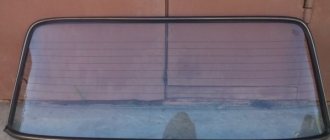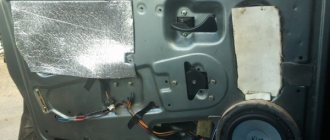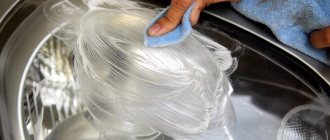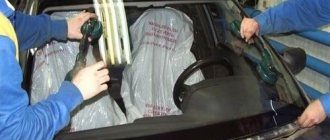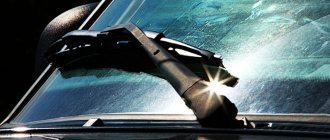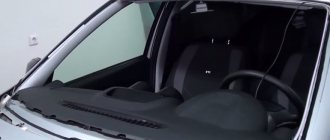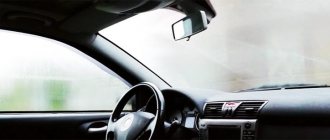Stickers on a car windshield allow the driver to identify his personal vehicle. The stickers are durable and weatherproof. They will help hide the cracks, and if desired, you can remove them without effort.
Drawings are used for different purposes:
- Hide the defect. Such stickers do not carry any meaning. The inscriptions “You can’t overtake”, “I have nothing to lose”, “I’m not drunk - I drive around pits” are pasted on for fun or to hide a visible flaw - a scratch, crease, chip, crack.
- Submit information. The drawings warn about the presence of a child in the car, a woman driving, etc. The “Spikes” badge is required and must be installed in the upper left corner of the rear window.
- Replacement of airbrushing. Stickers are inexpensive, while a professionally made drawing will cost the car enthusiast a pretty penny. If necessary, the sticker can be removed or replaced with another image. Airbrushing can only be painted over.
- Advertising. Helps the car owner promote his business. Advertising with a phone number increases the chances of finding new customers. Large companies offer drivers to place information about their company in the form of a sticker on the rear window. In exchange, drivers receive a reward.
Stickers as a way of advertising
One of the ways of marketing has become advertising stickers of various subjects. This could be company logos, contact information, a brief description of the service, or part of an advertising slogan. The more impressive the image on the glass, the greater the chances of attracting new customers and increasing income. Luminous images are becoming increasingly popular. The drawings are visible in the dark, which attracts the attention of passers-by and drivers. This is often used by taxis and delivery services.
Informativeness and originality
Stickers can carry useful information, for example, informing that there is an inexperienced car owner, a child, a car is for sale, or the driver is driving on studded tires - these are examples of the use of informative stickers.
Manufacturing materials
Stickers are made from various materials. Let's list all possible options, starting with the most popular:
- Vinyl film. An acceptable option that is resistant to changes in climatic conditions. Retains ideal shape from 2 to 10 years, which depends on the thickness of the film and its quality. With the help of a vinyl sticker it is easy to remove a visible defect.
- Fluorescent film. It has a special brightness. Valued by drivers who often drive in the dark. The service life is no more than 1 year. Later the film begins to fade.
- PVC film with reflective microspheres included. Able to reflect light from a source, it is visible in the dark, withstands scratches and lasts up to 3 years. In brightness it is inferior to fluorescent film.
- Tinting film. Most drivers prefer film that protects from sunlight. Tinting helps protect the driver from the sun and the interior from fading.
Use Cases
Lettering is put on the windshield to satisfy personal interests.
Drawings are used for different purposes:
- Hide the defect. Such stickers do not carry any meaning. The inscriptions “You can’t overtake”, “I have nothing to lose”, “I’m not drunk - I drive around pits” are pasted on for fun or to hide a visible flaw - a scratch, crease, chip, crack.
- Submit information. The drawings warn about the presence of a child in the car, a woman driving, etc. The “Spikes” badge is required and must be installed in the upper left corner of the rear window.
- Replacement of airbrushing. Stickers are inexpensive, while a professionally made drawing will cost the car enthusiast a pretty penny. If necessary, the sticker can be removed or replaced with another image. Airbrushing can only be painted over.
- Advertising. Helps the car owner promote his business. Advertising with a phone number increases the chances of finding new customers. Large companies offer drivers to place information about their company in the form of a sticker on the rear window. In exchange, drivers receive a reward.
Stickers as a way of advertising
One of the ways of marketing has become advertising stickers of various subjects. This could be company logos, contact information, a brief description of the service, or part of an advertising slogan. The more impressive the image on the glass, the greater the chances of attracting new customers and increasing income. Luminous images are becoming increasingly popular. The drawings are visible in the dark, which attracts the attention of passers-by and drivers. This is often used by taxis and delivery services.
Informativeness and originality
Stickers can carry useful information, for example, informing that there is an inexperienced car owner, a child, a car is for sale, or the driver is driving on studded tires - these are examples of the use of informative stickers.
Pasting methods
If the car owner does not know how to stick a sticker on the glass, then the following recommendations will help:
- First choose the side of the glass. It is better to fix the darkening film from the inside - it will not last long if it is exposed to precipitation. Stickers are glued on the outside.
- Clean the glass using professional auto chemicals. Wait until the surface is completely dry. The recommendations on the packaging are taken into account, which tell you how to apply the sticker to the car glass.
- If there are no instructions, then arrange the drawing according to your own understanding and fix it with masking tape.
- Peel off the tape, remove part of the protective film from the design, then cut off the edge and glue the sticker from the middle to the edge. The resulting bubbles and creases are removed by hand or with a blunt spatula.
- Remove the remaining tape and add part of the design.
If the technology is followed exactly, the image will last for years. When installing luminous film, it is advisable to seek the help of a specialist.
Features of operation
To glue the workpiece for a long period of time and not be afraid that it will fall off, follow a few rules:
- Do not wet the paper backing, otherwise it will be difficult to remove. Particles of paper remaining on the surface will contribute to the workpiece peeling off;
- Do not overheat the vinyl with a hair dryer to a temperature above 70 degrees, or it will begin to deform and lose its properties;
- use a plastic squeegee for the mounting coating so as not to scratch the vinyl itself;
- the temperature indoors or outdoors should be no lower than +10 and no higher than +30 degrees. At other temperature conditions, gluing the sticker will be very problematic;
- There should not be a lot of dust in the room or street where you will glue the film. If it gets under the film, it will prevent it from adhering to the surface.
Car vinyl wrap
Is a fine possible?
When stickers on a car block the view, the driver will be fined. Violation of technical regulations and the collection of traffic rules is punishable by administrative measures. A traffic police officer can issue a warning if the driver does not immediately get rid of the sticker on the car glass, but the police officer has the right to choose a different preventive measure. The minimum fine for a windshield sticker is 500 rubles, the maximum penalty is confiscation of license plates until the driver removes the stickers on the car.
Advantages and disadvantages
Vinyl films have many advantages, but one of the main ones is that the cost of vinyl stickers is relatively low. Pasting the entire body will cost about 30 thousand rubles, and the cost of applying vinyl to individual body elements will be 5-6 thousand rubles, which is quite affordable for most car enthusiasts. The same airbrush will cost 3-4 times more. If we compare it with the Oracal adhesive film, which belongs to the category of inexpensive films, then this difference will be even greater.
Noticeable cost savings when using vinyl films also occur due to the fact that the idea for a future image can be gleaned from the Internet. In this case, you won’t have to resort to the expensive services of a professional artist. And if you have skills in working in the Corel Draw program, then you can even draw a sketch of the future image yourself. And in this case, the DIY car sticker will be one hundred percent original. With the same ease, you can place advertising on your car.
It is also important that the vinyl coating performs a protective function, protecting the body from chips and scratches. And thanks to the relatively large thickness of some films, they can even protect the side of the car, which suffers the most in urban conditions. In addition, vinyl stickers can hide almost any flaws on the car body, which will allow you to avoid having to repaint it and, in the end, again allow you to save a lot of money.
If circumstances change, then the vinyl film can be removed from the car body as soon as possible. But in this case, you must be prepared for the fact that the part of the body on which the film was not applied will be slightly different in color from the places where the vinyl sticker was located. This is due to the fact that the pigmentation of the base paint on the body changes slightly under the influence of sunlight. After some time, everything will return to normal, but at first the differences may be noticeable. This is the main disadvantage of vinyl stickers.
How to remove a sticker
To remove stickers from car glass, it is better to select a special product that will not destroy the surface. Home remedies cannot be used, they will damage the surface, and it will be even more difficult to remove the sticker from the glass. There are special chemical compounds on sale that will remove the sticker and dissolve any remaining adhesive from the surface:
- Solvent 50 Kontakt chemistry This solvent gets rid of any drawings, glue, or double-sided tape. You need to use the product with gloves.
- TESA. The cleaner helps remove glue from patterns on glass. Eliminates thin stickers.
- UHU. Able to cope with traces of drawings, stickers, labels, glue. Dissolves thick stickers.
It doesn’t matter what you decide to use to remove the sticker from the car window - the chemicals are aggressive, so you need to wear rubber gloves when cleaning the glass. At the end of the procedure, wash off the remaining product from the glass with plain water.
Car stickers are beautiful and unusual, but if they interfere with road safety, then think twice before deciding to place the design you like. The main thing is to comply with the rules of the Technical Regulations.
How to remove glue residue from car surfaces and glass
Residues of glue can be removed by first moistening them with alcohol or alcohol-containing mixtures. Be careful when using different solvents. Read their composition first to make sure that they will not damage the paintwork of your car. In particular, in this case, you cannot use acetone-based solvents, as well as acetone itself.
You can also remove vinyl stickers on your car using:
Comparison of different sticker and adhesive removers
- gasoline;
- kerosene;
- liquids for removing bitumen stains;
- silicone solution for removing glue from the body;
- degreaser for painting work.
After using the listed liquids, do not forget to use foam (soap solution) to wash off any remaining residue. Also, some car owners in such cases remove glue residues using very fine sandpaper (“zero”). However, after this the problem area will need to be polished using polishing paste. In stores you can find a special rubber roller that fits onto a drill. It can also be used to quite effectively remove pre-softened glue.
Results
Applying film to a car is not particularly difficult. This is especially true for small size stickers. Almost any car owner can handle this. It’s another matter if you want to use vinyl stickers on the car throughout the entire body (for example, “carbon-look”). In this case, it is better to seek help from the experts.
Shockproof film for car glass
Armored film on glass protects a vehicle from mechanical influences and the effects of brute physical force. But this does not mean that such material will protect the surface of the car from firearms. In other words, it is an anti-shock film that provides longer glass life and protection.
Damage to car glass
How to remove glue residue from car surfaces and glass
Residues of glue can be removed by first moistening them with alcohol.
or alcohol-containing mixtures. Be careful when using different solvents. Read their composition first to make sure that they will not damage the paintwork of your car. In particular, in this case, you cannot use acetone-based solvents.
, both directly and with acetone itself.
You can also remove vinyl stickers on your car using:
Comparison of different sticker and adhesive removers
- gasoline;
- kerosene;
- removal liquids;
- silicone solution for removing glue from the body;
- degreaser for painting work.
After using the listed liquids, do not forget to use foam (soap solution) to wash off any remaining residue. Also, some car owners in such cases remove glue residues using very fine sandpaper (“zero”). However, after this the problem area will need to be polished using polishing paste. In stores you can find a special rubber roller that fits onto a drill. It can also be used to quite effectively remove pre-softened glue.
Results
Applying film to a car is not particularly difficult. This is especially true for small size stickers. Almost any car owner can handle this. It’s another matter if you want to use vinyl stickers on the car throughout the entire body (for example, “carbon-look”). In this case, it is better to seek help from the experts.
Today there are different methods of tuning a car, but most of the options require serious financial investments.
Let's take a closer look at external car tuning using car stickers!
Stickers are one of the easiest and most inexpensive ways to add some zest to your car, attract attention, and inform others about the special status of the car. Depending on the purpose, the following types of stickers are distinguished:
Depending on the purpose, the following types of stickers are distinguished:
- Graphic car stickers - a variety of graphic designs and collages give freedom to self-expression and more subtly emphasize the inner world of the car owner.
- Advertising – contain information of an advertising nature, for example, about the sale or purchase of goods with contact information.
- Informational – these include stickers of taxi services, driving schools, and government agencies.
- Signs - they are glued, for example, by novice drivers or parents carrying a baby in the cabin.
- Humorous - you've probably met car enthusiasts on the roads whose cars have inscriptions like “I often confuse the pedals” or “First day behind the wheel.”
Films (glossy and matte) are also divided into:
- special high-quality (intended only for application to glass),
- reflective (visible at night),
- light-accumulating (accumulate the energy of sunlight during the day and release it at night in the form of a beautiful glow).
Low pressure tires
Good day, friends. Not long ago we looked at tracked modules for SUVs - an excellent tool for increasing the cross-country ability of a vehicle. Today we’ll talk about another great invention - low and ultra-low pressure tires. The difference between low- and ultra-low-pressure wheels is arbitrary, so it can be neglected. So, what are the good things about pneumatics, what are their features, advantages and disadvantages? How much do they cost and is it possible to make low-pressure tires with your own hands? Let's try to answer these questions.
Aveo carbon fiber trim
If you are dealing with carbon-look film for the first time, then first master the principles of working with it by gluing small parts.
For example, the linings on the front door handles in a Chevrolet Aveo quickly lose their attractive appearance, because... The silver coating on them quickly wears off from the knees. You can also use film to cover inserts on the steering wheel, plastic in the area of the handbrake, door handles, a panel with a switch for adjusting the side mirrors and the angle of low beam lamps, panels in the area of the audio system, glove compartment, etc.
Trimming the interior with carbon fiber inserts will definitely improve the interior of the Aveo.

